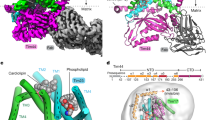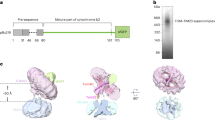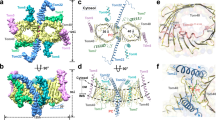Abstract
The mitochondrial outer membrane contains machinery for the import of preproteins encoded by nuclear genes1,2,3. Eight different Tom (translocase of outer membrane) proteins have been identified that function as receptors and/or are related to a hypothetical general import pore. Many mitochondrial membrane channel activities have been described4,5,6,7, including one related to Tim23 of the inner-membrane protein-import system5; however, the pore-forming subunit(s) of the Tom machinery have not been identified until now. Here we describe the expression and functional reconstitution of Tom40, an integral membrane protein with mainly β-sheet structure. Tom40 forms a cation-selective high-conductance channel that specifically binds to and transports mitochondrial-targeting sequences added to the cis side of the membrane. We conclude that Tom40 is the pore-forming subunit of the mitochondrial general import pore and that it constitutes a hydrophilic, ∼22 Å wide channel for the import of preproteins.
This is a preview of subscription content, access via your institution
Access options
Subscribe to this journal
Receive 51 print issues and online access
$199.00 per year
only $3.90 per issue
Buy this article
- Purchase on SpringerLink
- Instant access to full article PDF
Prices may be subject to local taxes which are calculated during checkout



Similar content being viewed by others
References
Schatz, G. & Dobberstein, B. Common principles of protein translocation across membranes. Science 271, 1519–1526 (1996).
Neupert, W. Protein import into mitochondria. Annu. Rev. Biochem. 66, 863–917 (1997).
Pfanner, N., Craig, E. A. & Hönlinger, A. Mitochondrial preprotein translocase. Annu. Rev. Cell Dev. Biol. 13, 25–51 (1997).
Moran, O., Sandri, G., Panfili, E., Stühmer, W. & Sorgato, C. Electrophysiological characterization of contact sites in brain mitochondria. J. Biol. Chem. 265, 908–913 (1990).
Lohret, T. A., Jensen, R. E. & Kinnally, K. W. Tim23, a protein import component of the mitochondrial inner membrane, is required for normal activity of the multiple conductance channel, MCC. J. Cell Biol. 137, 377–386 (1997).
Juin, P., Thieffry, M., Henry, J.-P. & Vallette, F. M. Relationship between the peptide-sensitive channel and the mitochondrial outer membrane protein translocation machinery. J. Biol. Chem. 272, 6044–6050 (1997).
Dihanich, M., Schmidt, A., Oppliger, W. & Benz, R. Identification of a new pore in the mitochondrial outer membrane of a porin-deficient yeast mutant. Eur. J. Biochem. 181, 703–708 (1989).
Baker, K. P., Schaniel, A., Vestweber, D. & Schatz, G. Ayeast mitochondrial outer membrane protein essential for protein import and cell viability. Nature 348, 605–609 (1990).
Mannella, C. A., Neuwald, A. F. & Lawrence, C. E. Detection of likely transmembrane β-strand regions in sequences of mitochondrial pore proteins using the Gibbs sampler. J. Bioenerg. Biomembr. 28, 163–169 (1996).
Schmid, B., Krömer, M. & Schulz, G. E. Expression of porin from Rhodopseudomonas blastica in Escherichia coli inclusion bodies and folding into exact native structure. FEBS Lett. 381, 111–114 (1996).
Sreerama, N. & Woody, R. W. Protein secondary structure from circular dichroism spectroscopy: combining variable selection principle and cluster analysis with neural network, ridge regression and self-consistent methods. J. Mol. Biol. 242, 497–507 (1994).
Hille, B. in Ionic Channels of Excitable Membranes. Ch. 9, 11 (Sinauer, Sunderland, Massachusetts, 1992).
Hinnah, S., Hill, K., Wagner, R., Schlicher, T. & Soll, J. Reconstitution of a chloroplast protein import channel. EMBO J. 16, 7351–7360 (1997).
Smart, O. S., Breed, J., Smith, G. R. & Sansom, M. S. Anovel method for structure-based prediction of ion channel conductance properties. Biophys. J. 72, 1109–1126 (1997).
Krasilnikov, O. V., Sabirov, R. Z., Ternovsky, V. L., Merzliak, P. G. & Muratkhodjaev, J. N. Asimple method for the determination of the pore radius of ion channels in planar lipid bilayer membranes. FEMS Microbiol. Immunol. 5, 93–100 (1992).
Alconada, A., Gärtner, F., Hönlinger, A., Kübrich, M. & Pfanner, N. Mitochondrial receptor complex from Neurospora crassa and Saccharomyces cerevisiae. Methods Enzymol. 260, 263–286 (1995).
Dietmeier, K. et al. Tom5 functionally links mitochondrial preprotein receptors to the general import pore. Nature 388, 195–200 (1997).
Dekker, P. J. T. et al. The Tim core complex defines the number of mitochondrial translocation contact sites and can hold arrested preproteins in the absence of matrix Hsp70-Tim44. EMBO J. 16, 5408–5419 (1997).
Allison, D. S. & Schatz, G. Artificial mitochondrial presequences. Proc. Natl Acad. Sci. USA 83, 9011–9015 (1986).
Brix, J., Dietmeier, K. & Pfanner, N. Differential recognition of preproteins by the purified cytosolic domains of the mitochondrial import receptors Tom20, Tom22, and Tom70. J. Biol. Chem. 272, 20730–20735 (1997).
Rapaport, D., Neupert, W. & Lill, R. Mitochondrial protein import: Tom40 plays a major role in targeting and translocation of preproteins by forming a specific binding site for the presequence. J. Biol. Chem. 272, 18725–18731 (1997).
Mayer, A., Neupert, W. & Lill, R. Mitochondrial protein import: reversible binding of the presequence at the trans side of the outer membrane drives partial translocation and unfolding. Cell 80, 127–137 (1995).
Vestweber, D. & Schatz, G. DNA-protein conjugates can enter mitochondria via the protein import pathway. Nature 338, 170–172 (1989).
Künkele, K.-P. et al. The preprotein translocation channel of the outer membrane of mitochondria. Cell 93, 1009–1019 (1998).
Matlack, K. E. S., Mothes, W. & Rapoport, T. A. Protein translocation: tunnel vision. Cell 92, 381–390 (1998).
Vestweber, D., Brunner, J., Baker, A. & Schatz, G. A24K outer-membrane protein is a component of the yeast mitochondrial protein import site. Nature 341, 205–209 (1989).
Kiebler, M. et al. Identification of a mitochondrial receptor complex required for recognition and membrane insertion of precursor proteins. Nature 348, 610–616 (1990).
Söllner, T. et al. Mapping of the protein import machinery in the mitochondrial outer membrane by crosslinking of translocation intermediates. Nature 355, 84–87 (1992).
Hönlinger, A. et al. The mitochondrial receptor complex: Mom22 is essential for cell viability and directly interacts with preproteins. Mol. Cell. Biol. 15, 3382–3389 (1995).
Bolliger, L., Junne, T., Schatz, G. & Lithgow, T. Acidic receptor domains on both sides of the outer membrane mediate translocation of precursor proteins into yeast mitochondria. EMBO J. 14, 6318–6326 (1995).
Acknowledgements
We thank P. J. T. Dekker, B. Guiard, M. Kiebler, W. Kühlbrandt, D. Mills, J. Brix, S. C. Hinnah and H. Martin for materials, advice and discussion. This work was supported by the Deutsche Forschungsgemeinschaft, Sonderforschungsbereich 388, the Fonds der Chemischen Industrie (N.P.), the Sonderforschungsbereich 171 (R.W.) and a longterm fellowship of the Alexander-von-Humboldt Foundation (M.T.R.)
Author information
Authors and Affiliations
Corresponding author
Rights and permissions
About this article
Cite this article
Hill, K., Model, K., Ryan, M. et al. Tom40 forms the hydrophilic channel of the mitochondrial import pore for preproteins. Nature 395, 516–521 (1998). https://doi.org/10.1038/26780
Received:
Accepted:
Issue Date:
DOI: https://doi.org/10.1038/26780



